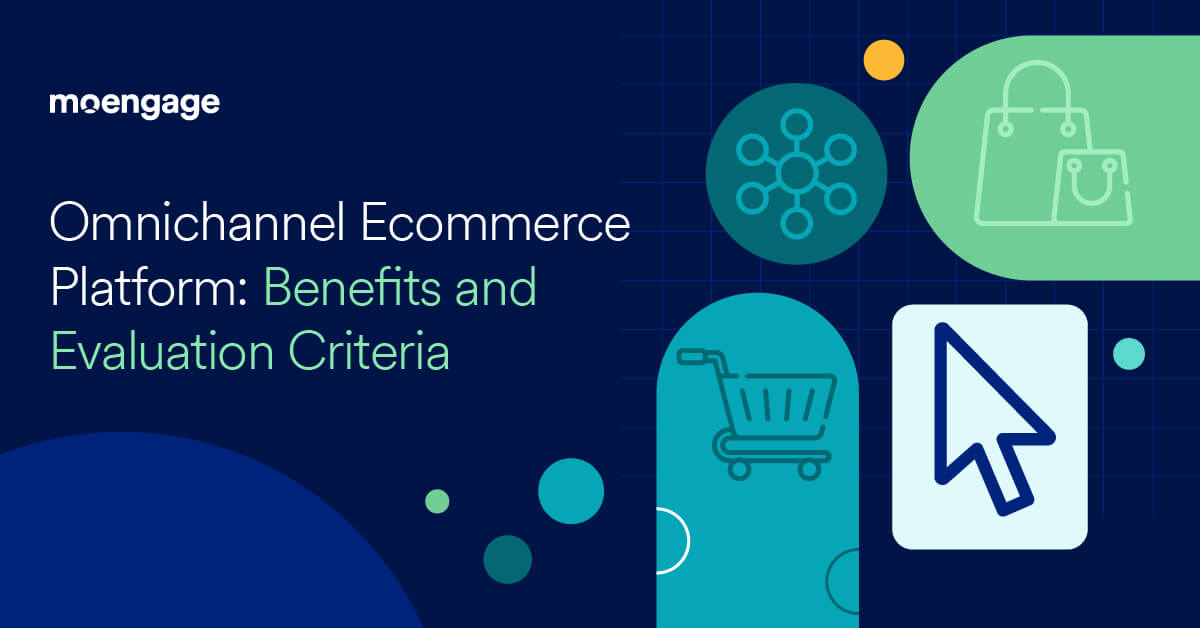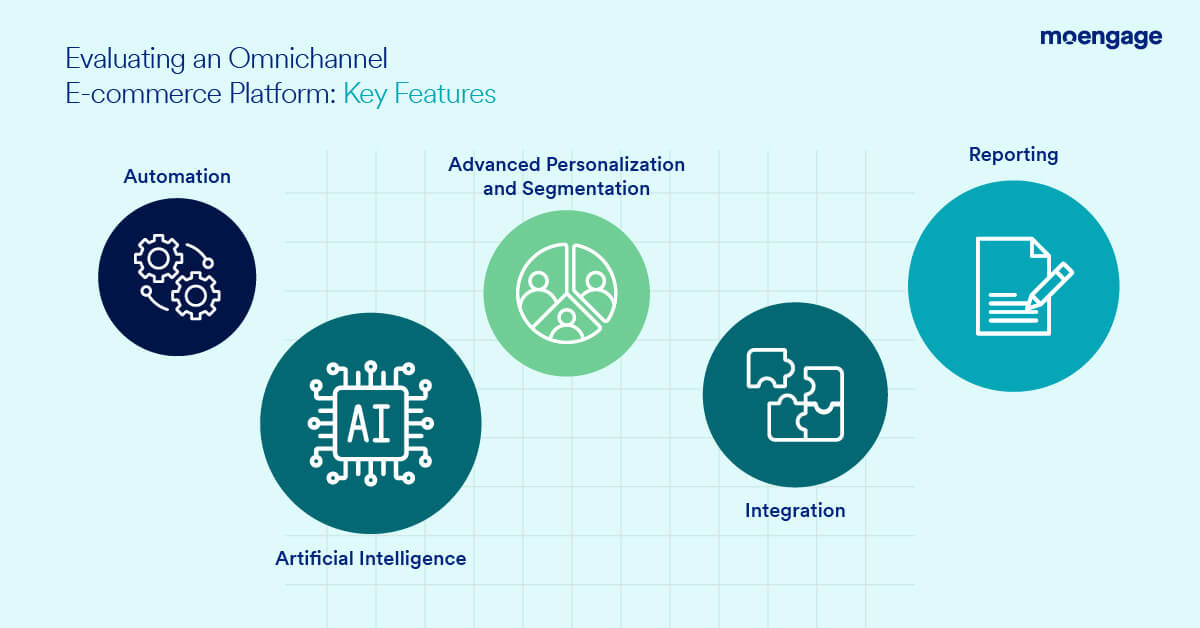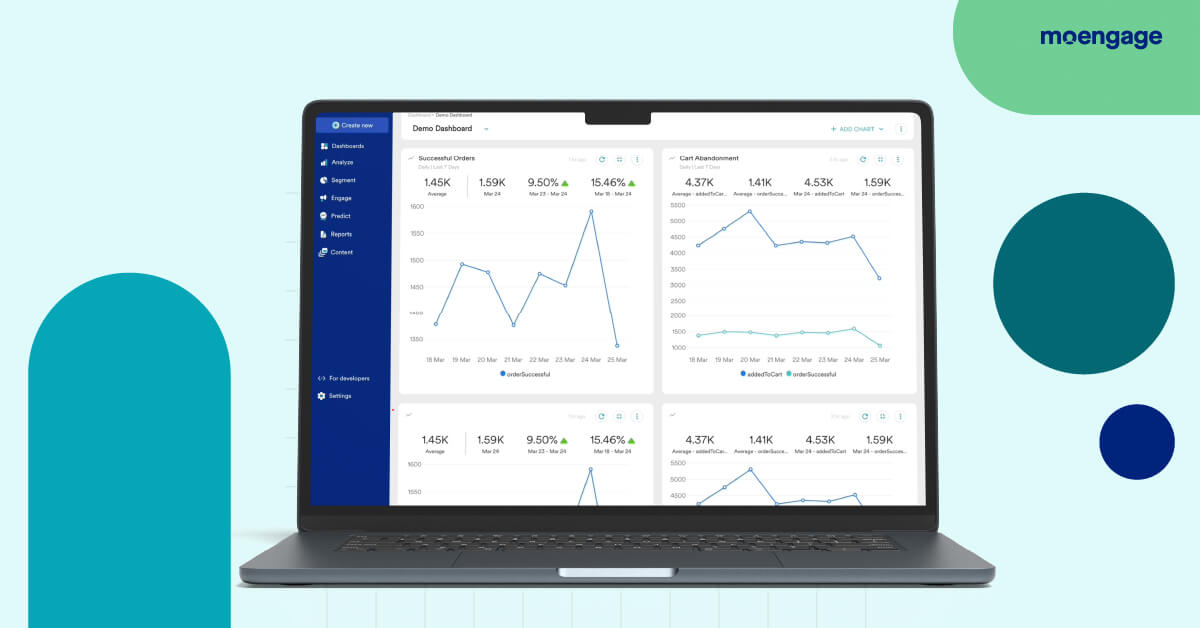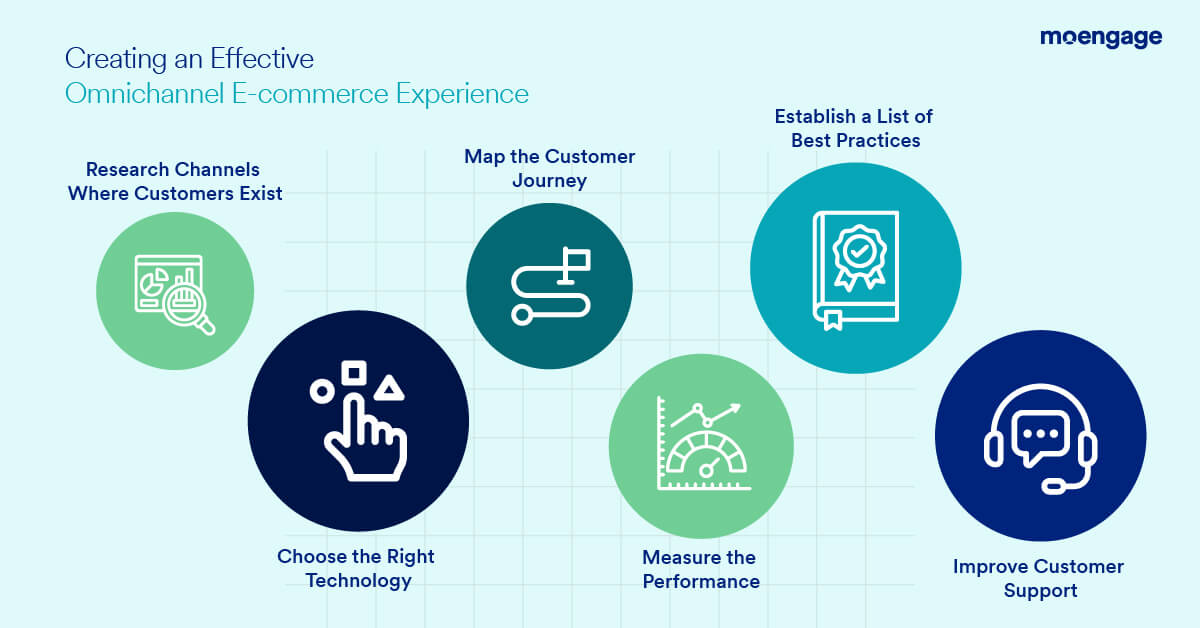Omnichannel Ecommerce Platform: Benefits and Evaluation Criteria

Reading Time: 11 minutes
An omnichannel ecommerce platform is software that helps ecommerce brands deliver a consistent customer experience across all touchpoints. It ties all the channels together to ensure that customers can shop from any channel, anytime, without interrupting their shopping experiences.
This uninterrupted and seamless customer journey helps companies engage with customers and improve conversions.
In this blog, we’ll walk you through:
- What is Omnichannel in Ecommerce?
- Five Benefits of Providing an Omnichannel Ecommerce Experience
- Omnichannel Ecommerce Platform Evaluation Criteria: How to Choose One
- Best Omnichannel Ecommerce Platform: Key Features
- How to Create an Effective Omnichannel Ecommerce Experience
- Provide the Best Omnichannel Ecommerce Experience to Your Customers with MoEngage
This will help you understand the benefits of adopting an omnichannel ecommerce strategy and the significance of using an omnichannel ecommerce platform.
What is Omnichannel in Ecommerce?
Omnichannel ecommerce connects channels like SMS, social media, emails, and offline stores to create a unified and seamless customer experience. The aim is to reach customers where they are and make it easy for them to shop anywhere, anytime they want.
In the last few years, omnichannel ecommerce has become more prevalent than pure ecommerce or brick-and-mortar stores. According to a study nine out of 10 consumers prefer an omnichannel experience.
And why not? Omnichannel experiences in ecommerce have a number of benefits, including:
- Uninterrupted shopping experience: Customers can shop with any device without worrying about starting the search from scratch. They can start the search from a mobile phone and checkout from a laptop, or compare prices on a computer and buy from the store, and so on. Omnichannel commerce caters to all types of customer journeys.
- Convenience: Customers can purchase anything with the click of a button and without spending hours at the store. Convenience matters so much to customers that according to a PWC study on the future of customer experience, 43% of customers are even willing to pay more for it.
- Flexibility in shopping: Customers can shop any way they desire. For example, they can order online and pick from a nearby shop.
Let’s discuss them in more detail below.
Five Benefits of Providing an Omnichannel Ecommerce Experience
Previously, ecommerce brands used conventional strategies like mass-marketing and focusing on just one channel to serve customers. However, as brands added more channels, the need for an omnichannel strategy became significant. Here are some ways ecommerce companies can benefit from the omnichannel approach.
1. Consistent messaging
Traditionally, ecommerce marketers focused on one channel at a time. Every channel was treated separately. Hence, there was no consistency in brand voice or experience. This frustrated customers because they would often receive different messages from different channels.
On the other hand, the current omnichannel ecommerce strategy involves creating a centralized view of customer interactions and synchronizing all the communication channels. This helps the marketer better understand the customer’s purchase intent, tailor communication based on their behavior, and send consistent, relevant messages across all touchpoints.
Moreover, since all the channels are integrated, customers experience a continued conversation even if they decide to switch channels. This consistency in messaging helps create a high recall value for the brand.
2. Better engagement
Omnichannel ecommerce increases customer engagement, which leads to a decrease in churn rates and increased spending. For example, a study by Zendesk indicates that 70% of customers spend more on brands that use a smart omnichannel strategy.
But to build better engagement, brands must connect with their customers at every touchpoint and send them the right message at the right time.
Traditional ecommerce brands need help in this area as their channels are often unintegrated, preventing them from providing a seamless customer experience. They have limited visibility of the customer’s journey and fail to send the relevant messages to the customer at the right time. Every attempt at engaging with them becomes a hit-or-miss opportunity.
Omnichannel ecommerce platforms can solve this problem by giving marketers better visibility of the customer’s journey as all platforms are tied together. They can easily align the messages with the customer’s journey and ensure they receive contextually relevant information at the right time.
3. Cohesive customer experience
Some customers will buy a product online and pick it up from the store or purchase it online and return it in the store. Either way, you must be prepared to offer a consistent experience to the customer across every channel.
Unfortunately, old ecommerce platforms were not designed to support such dynamic journeys; either their channels are not integrated or they function in silos. This leads to a fragmented customer experience.
Omnichannel ecommerce solutions, on the other hand, support different journeys. They tie all the channels together, ensuring seamless data transfer and transparency. Brands get a holistic customer view.
It helps them deeply understand the customer’s buying and behavioral patterns and offer a consistent experience across all touchpoints.
4. Customer-centricity
It’s no secret that customer-centricity is essential for customer retention and business growth. According to What It Means, a podcast by Forrester, 41% of customer-obsessed companies achieved a 10% revenue growth in their last fiscal year as compared to companies that didn’t prioritize their customers, and therefore didn’t see such growth.
Traditional ecommerce solutions focus more on bringing a brand’s products to the customer. They do not prioritize customer experience or limit it to individual channels. It leaves the customers dissatisfied.
Omnichannel ecommerce solutions are more customer-centric. They focus more on creating a seamless experience for customers across all touchpoints. Marketers tie all customer touchpoints to create several “aha” moments throughout the journey.
5. Hyper-personalization
According to our recent Personalization Pulse Check survey, 26% of American customers expect personalized experiences from brands. 30% of female and 41% of male executives expressed frustration over receiving inconsistent messages across different channels. This shows how hyper-personalized experience and communication have become critical for ecommerce brands.
Hyper-personalized experiences require ready access to real-time customer data from all sources. However, the need for integration between different channels limits the capabilities of old ecommerce platforms.
Omnichannel ecommerce solutions integrate all channels and collect data about the customer from various sources. It gives them a complete picture of the customer’s pain points, preferences, and lifestyle.
This helps brands understand the customer more deeply and personalize everything – from products and services to communication to meet customer expectations.
Omnichannel Ecommerce Platform Evaluation Criteria: How to Choose One
According to the insights from our State of Cross-Channel Marketing 2024, spreadsheets are the #1 software/tool used to drive omnichannel marketing in the retail and ecommerce industry. In other words, 21.6% of B2C marketers conduct manual analysis to manage their customer engagement programs. This methodology is prone to numerous human errors and isn’t scalable.
Alternatively, investing in an automated omnichannel ecommerce platform can streamline processes, improve collaboration, and provide advanced analytics for building hyper-personalized customer experiences.
But, there are countless omnichannel ecommerce platforms, each promising to deliver a cohesive customer experience.
So how do you choose THE ONE?

Below, we’ve enlisted a few parameters to help you compare and choose the right omnichannel ecommerce software.
1. Automation
As brands add more touchpoints, manual execution of omnichannel strategies can become challenging. To add to the woes, customer needs change frequently. Legacy ecommerce platforms are not built for dynamic situations.
Marketers have to segment customers and deploy campaigns manually. This was a resource and time-intensive process. Additionally, there were chances of errors seeping into the campaign. That’s why you must prioritize automation capabilities when choosing an omnichannel ecommerce platform.
Automation will help you operationalize customer journeys across all channels at scale, segment customers, and deploy marketing campaigns without hassle.
MoEngage’s platform can automate strategies and deliver personalized customer experiences at all stages.
Take Cocomelody, for example.
This popular bridal wear company used MoEngage to personalize their cross-channel communication. It helped the brand analyze, optimize, and personalize campaigns in real-time and enabled them to trigger relevant content to loyal customers, allowing them to increase the repurchase rate by 27% and online ROAS by 69%.
| You can read more customer success stories to learn how MoEngage can help you achieve business success. |
2. AI-driven capabilities
Almost every omnichannel ecommerce software automates processes. However, additional artificial intelligence and machine learning (AI/ML) capabilities can give your campaigns an extra edge.
Platforms utilizing AI and ML can gather real-time data on your customers’ preferences and help you meet their expectations at the right time.
For example, AI can sense price sensitivity or a customer’s propensity to buy a product and recommend the right bundling or pricing offer. It can also help you keep the communication relevant to the customer and send the right message at the right time.
MoEngage’s Omnichannel Marketing Platform, for example, is built with AI-powered Sherpa. It helps marketers identify the best journey for customers, experiment with multiple journeys, and remove all the guesswork from marketing automation.
It increases the capability to boost conversions by also figuring out the best time to send communication and the best channel(s).
3. Advanced personalization and segmentation capabilities
Customer journeys are getting increasingly complex with the addition of new channels in the ecommerce space.
According to insights from our State of Cross-Channel Marketing 2024 survey, the #1 customer segmentation roadblock for B2C marketers in the retail and ecommerce industry is inconsistent data quality from various channels (33.3%). Thus, even though 91.9% of B2C marketers are using some form of omnichannel personalization, their strategies aren’t very effective.
Omnichannel ecommerce platforms like MoEngage solve this problem by providing advanced segmentation and analytical capabilities that give an in-depth understanding of customers’ collective persona and help you deliver effective, hyper-personalized campaigns across all channels.
That’s how FoodHub, a UK-based online food store, improved customer experience. It used MoEngage to segment customers based on their previous selections, purchase cycles, and affinity. This allowed them to deliver hyper-personalized experiences to customers.
| Check out more examples of ecommerce personalization to see how MoEngage’s solution has helped brands ace personalization and boost ROI. |
4. Ability to integrate with other channels
The older versions of ecommerce platforms needed more integration capabilities. All channels functioned in silos, and there was no flow of data between them. This effectively meant that channel owners had limited visibility about the customer, which led to a fragmented and inconsistent experience.
When you choose an omnichannel ecommerce software, ensure that it integrates multiple channels seamlessly and consolidates all the data in a unified platform. MoEngage’s Omnichannel Platform integrates more than 10 channels, unifies the customer in one place, and helps marketers deliver targeted campaigns to each segment.
5. Reporting
How will you know if your omnichannel strategy worked without any data on its performance? Although most omnichannel ecommerce solutions have reporting capabilities, you cannot rely on them if they don’t measure the performance of your omnichannel strategy in real-time.
You need a platform that gives you real-time insights across all channels, allowing you to be agile and proactively meet customer expectations. It will help you stay clued into what the customer wants and iterate your omnichannel strategy accordingly.
With MoEngage’s omnichannel ecommerce solution, marketers can generate a unified report, analyze the customer’s behavior accurately, and act on it immediately.

Best Omnichannel Ecommerce Platform: Key Features
MoEngage is one of the best omnichannel ecommerce platforms for companies to build a cohesive customer experience. It provides all the features mentioned above. Here’s how you can benefit from using this platform:
| Omnichannel Ecommerce Platform Needs | MoEngage Feature | How this Helps |
| Automation | MoEngage’s omnichannel platform enables marketers to create marketing automation workflows in minutes and engage customers contextually across all channels and touchpoints. | It understands the evolving customer needs and shows the best possible customer journeys. This will help you execute automated marketing campaigns aligned with the customer journey. |
| AI-driven | MoEngage’s Sherpa is a natively built AI-powered engine that helps marketers eliminate guesswork, and optimize engagement and conversions by sending the right message to the right, at the right time. | Marketers don’t have to spend time manually creating marketing campaigns for different scenarios. MoEngage’s AI-powered platform will remove all the guesswork, automate complicated processes, and provide in-depth insights on each customer. |
| Advanced personalization and segmentation capabilities | MoEngage’s platform can boost engagement and conversions by 4x with its advanced personalization and segmentation capabilities. It can compare customer segments across various touchpoints and deploy personalized campaigns for customer journeys, such as cart abandonment, product recommendations, price drops, etc. | Advanced personalization and segmentation capabilities help companies personalize experiences and engage with customers at all customer journey stages. |
| Cross-channel marketing | MoEngage’s platform can integrate more than 10 channels into a single platform. | It helps marketers collect customer data from different sources and create a single profile, making it easy for them to understand the customer more deeply and offer personalized experiences that meet their expectations. |
| Integration | MoEngage’s app marketplace allows companies to discover and integrate their preferred apps natively with MoEngage. | Companies can seamlessly share data and insights between the apps and harness it at the right moment to deliver personalized experiences to customers across different channels. |
| Ease of use | MoEngage’s omnichannel ecommerce platform provides a drag-and-drop editor that helps marketers design campaigns quickly. It can also orchestrate omnichannel campaigns from a single platform. | These features help marketers save time designing, launching, and managing omnichannel campaigns. |
How to Create an Effective Omnichannel Ecommerce Experience
According to McKinsey’s research on omnichannel experiences, more than 50% of customers engage with three to five channels in their buying journey. Clearly, today’s customers are spoilt for choice.
With so many channels available for shopping, building an omnichannel ecommerce experience can seem challenging.
While omnichannel ecommerce platforms can empower you to create a consistent experience across all channels, it’s just one component of a successful omnichannel ecommerce strategy.

Here are some actionable steps you can take to create a well-rounded omnichannel ecommerce experience:
1. Research channels where customers exist
The omnichannel ecommerce approach is built on the idea of reaching where the customer is present. For example, according to The Global Consumer Trends Report, 31.6% of North American customers spend the most on online shopping and 55.8% prefer buying products through their smartphones instead of visiting a physical store.
Hence, the first step to implementing an omnichannel ecommerce strategy is understanding your customers and their channel preferences.
Start by identifying the channels and platforms used frequently by your customers and understanding how they interact with them. Tools like Google Analytics can gather customer data and help you understand the customer’s preferences and pain points.
Next, use these insights to zero in on the top priority channels and plan your strategy accordingly. Also, leverage your omnichannel ecommerce platform to conduct A/B testing and find out the channels and channel combinations that resonate most with your customers.
2. Understand the customer and map the journey
No two customers are the same. Each one of them follows a unique shopping journey. That’s why understanding the customer and their behavior pattern is so crucial.
Here are a few factors you should consider while studying the customer:
- Demography: Get details about their age, income level, ethnicity, location, interests, and aspirations.
- Buying habits: Look into the recency, frequency, and monetary (RFM) traits. For example, check how frequently they purchase, how many transactions they made recently, and the monetary value of the transactions.
- Technology use: Gain insights on what devices and channels they use to engage with your brand.
Use these insights to identify the key touchpoints and stitch them together to create a seamless customer journey.
3. Choose the right technology to execute
Stitching together all the channels to provide a unified experience can be quite a hassle for companies. The right omnichannel ecommerce software will help you integrate all the channels, automate processes, and deliver a seamless experience to customers.
For instance, MoEngage’s Omnichannel Marketing platform boosts customer retention by 4x for ecommerce companies. Its AI-powered Sherpa eliminates all the guesswork from automation and helps you send the right message at the right time through a proper channel. It can segment customers based on their collective personas and help you craft personalized campaigns to engage each segment at every step of the customer journey.
Study the omnichannel ecommerce platforms carefully, compare them, and choose the one to help you successfully create and deliver personalized campaigns. Check out the Enterprise Customer Engagement Platform Buyer’s Guide for a deeper dive into how to do this.
4. Measure the performance and address the gaps
Once you deploy your strategy, monitor its performance carefully. Define the Key Performance Indicators (KPIs) for the strategy and study how each channel performs. Understand what works the best and which ones need improvement. These insights will help you modify the strategy, optimize the efforts, and achieve your business goals.
5. Improve customer support
Poor or delayed customer service can increase customer churn. It is recommended that you Integrate all your communication channels to provide seamless and proactive customer support. So, no matter which channels your customers use to communicate with you, the experience remains consistent.
6. Establish best practices and follow them for more success
Don’t stop at implementing and measuring the strategy’s effectiveness. Keep improving it by following certain best practices. These could include:
- Optimizing every channel to make it shoppable
- Investing in a good tech stack that will deliver a seamless omnichannel experience
- Treat customer data as a sacred asset and protect it well
- Test, test, and test to provide the best customer experience across all channels
Provide the Best Omnichannel Ecommerce Experience to Your Customers with MoEngage
An omnichannel ecommerce platform is necessary to provide a smooth experience to your customers. It integrates all touchpoints and creates personalized, contextually relevant omnichannel campaigns that reach the right customer at the right time.
MoEngage’s Omnichannel Ecommerce Platform, with its AI-powered Sherpa and advanced segmentation and personalization capabilities, can help companies collect customer data across all channels, analyze them, and build high-conversion omnichannel campaigns.
Request a demo if you want to convert your window shoppers into customers and see your revenue grow!














